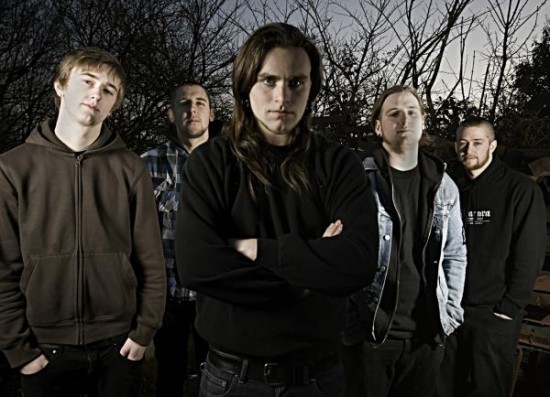
(Our UK contributor Andy Synn returns with another edition of The Synn Report.)
Ah “Deathcore”. In today’s current climate the word carries so many mixed connotations that it’s less of a genre-descriptive term and more of a full-on assault on a band’s right to exist. What’s worse is that, wrongly or rightly applied, the term has become synonymous with the WORST proponents of the style, rather than the BEST.
Young British tykes Trigger The Bloodshed were tarnished with the stain of ‘core from their earliest album. Granted, THAT name, their age, precociousness, and the timing of their first release didn’t help them much, but it’s still worth noting that although their first album did flirt with many of the elements so currently associated with the “deathcore” genre, the band always seemed less interested in being associated with a particular scene or style than they were in simply creating good, heavy music, placing a much greater emphasis on the “death” over the “core”.
All this, however, is not to say that associating purely with Big Daddy Death Metaltm doesn’t create some similar issues (the two genres being genetically intertwined after all). Both genre and sub-genre often suffer from an “overabundance of brutality” – a directionless focus on a perceived holy grail of heaviness, at the expense of actually saying anything lasting with the music. (more after the jump, including recommended songs from the TTB discography . . .)
In particular for me, this is a problem with the vocals; too often the guttural stylings are utilised efficiently but not particularly effectively, the lack of vocal catharsis and absence of believable emotional content leaving me cold. Sure, I enjoy a good serial killer/zombie apocalypse/rapist/end of the world story delivered over churning death metal riffs as much as the next guy, but too often the vocals are (merely) loud and (merely) brutal, but not (really) believably angry or able to capture the true rage and emotion of the singer’s invective. That’s not to say that there aren’t a lot of believably angry and truly emotionally transparent vocalists operating out there in death metal, I’m simply saying that the lack of such a singer is often a problem for me.
Anyway, now that some context has been established, onto the band in question…
Purgation – 2008
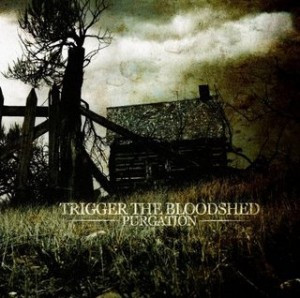 First *real* track “Merciless Ignorance” is a well-put together number. Concisely written, it manages to pack a series of vicious riffs and some complex shredding into it’s 1:47 length. Although the overly artificial drum sound is a bother, as a whole the song is extremely strong. Following with “Laceration”, the band continues to keep the intensity high. Moving between straight-ahead blasting and a slower, more rolling style, the song benefits from its increased run-time by managing to conjure a sense of greater atmosphere, aided and abetted by a brief but well-placed solo. Some of the shifts are occasionally a little rough, the repeated stop-start refrain occasionally butting heads with the rhythms around it, but overall it’s a well put together piece of music.
First *real* track “Merciless Ignorance” is a well-put together number. Concisely written, it manages to pack a series of vicious riffs and some complex shredding into it’s 1:47 length. Although the overly artificial drum sound is a bother, as a whole the song is extremely strong. Following with “Laceration”, the band continues to keep the intensity high. Moving between straight-ahead blasting and a slower, more rolling style, the song benefits from its increased run-time by managing to conjure a sense of greater atmosphere, aided and abetted by a brief but well-placed solo. Some of the shifts are occasionally a little rough, the repeated stop-start refrain occasionally butting heads with the rhythms around it, but overall it’s a well put together piece of music.
One of the difficulties in assessing this album is that the majority of the tracks flow into one another without any breaks, which gives the album a sense of cohesion, but also becomes problematic when you realise that several of the very short songs have gone by in turn without you realising it. I’d also question the decision to break up certain tracks in the manner that has been done; for example the punishing “Rebirth”, replete with massive central breakdown, flows in and out of a massive groove before leading into the Nile-esque majestic riffs and keys of “The Defiled” – these tracks work so well together I don’t fully understand why they aren’t simply considered as one song. They certainly function as one.
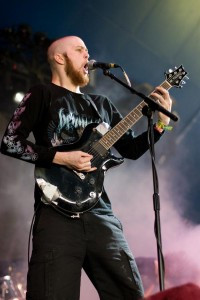 These moments, where different tracks coalesce into a greater whole, show the greatest promise for the band, managing to create a sense of mood and depth beyond simply riffing and blasting for the sake of it. In contrast, however, there is a sense of sterility to some of the material on offer, be it due to the predictable construction of the music (“Mortuary Walls“ and “Violent Elucidation” whilst promising, offer little beyond the expected) or the production style used (“Impregnable Miscreation” sounds particularly artificial). The overbearing snare sound (and occasionally artificial kick drums) are a definite gripe, the material coming across as clinically overproduced rather than as part of a naturally overwhelming force – closer “A Perfect Casket” is a perfect example of a good song marginalised by the artificiality of the drum sound.
These moments, where different tracks coalesce into a greater whole, show the greatest promise for the band, managing to create a sense of mood and depth beyond simply riffing and blasting for the sake of it. In contrast, however, there is a sense of sterility to some of the material on offer, be it due to the predictable construction of the music (“Mortuary Walls“ and “Violent Elucidation” whilst promising, offer little beyond the expected) or the production style used (“Impregnable Miscreation” sounds particularly artificial). The overbearing snare sound (and occasionally artificial kick drums) are a definite gripe, the material coming across as clinically overproduced rather than as part of a naturally overwhelming force – closer “A Perfect Casket” is a perfect example of a good song marginalised by the artificiality of the drum sound.
Returning to the issues of vocals raised in the introductory paragraphs, the performance by vocalist Charlie Holmes is definitely powerful, yet occasionally lacks conviction. On certain songs he seems to simply provide the requisite growls and screams as sonic wallpaper, never fully engaging the listener himself or standing out from the death-storm around him, whilst on other songs his voice sounds monstrously enraged and legitimately angry, his use of high and low vocal interplay, assured and powerfully delivered.
The use of short, atmospheric tracks (“Hollow”, “Domicile”) serves to tie the dark mood of the record together, although some of the shorter and more aggressive tracks showcase the band’s early limitations; “Severed” bludgeons and blusters adequately without ever really achieving anything, neither overwhelmingly heavy enough to justify its short running time, nor given enough opportunity to grow into something greater. “The Abortive Becoming” is also a song that would benefit from a bit more time and consideration, as the harsh, crunching ending begins too soon and aborts the track before it has really had time to find its feet and achieve any lasting impression.
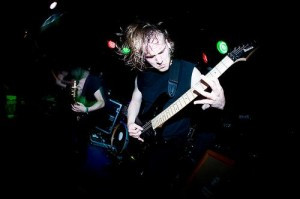 The album has clear strengths, however, unafraid to focus more on the “death” than on the “core” or (when appropriate) to reverse this and utilise these “core” elements in an effective manner. “Lovers” is a great piece of work, managing to integrate the melody and brutality of modern death metal with more positive elements usually associated with the “core” suffix. Inside the track “Whited Sepulcher” is a fine death metal anthem striving to get out, all Cannibal Corpse-esque groove and grind, held back by some uninspired (albeit powerful) drumming and vocals, whilst “Retribution” blurs the lines between “death” and “core” quite effectively by utilising some of modern death metal’s key tricks to enhance the sheer heaviness on display.
The album has clear strengths, however, unafraid to focus more on the “death” than on the “core” or (when appropriate) to reverse this and utilise these “core” elements in an effective manner. “Lovers” is a great piece of work, managing to integrate the melody and brutality of modern death metal with more positive elements usually associated with the “core” suffix. Inside the track “Whited Sepulcher” is a fine death metal anthem striving to get out, all Cannibal Corpse-esque groove and grind, held back by some uninspired (albeit powerful) drumming and vocals, whilst “Retribution” blurs the lines between “death” and “core” quite effectively by utilising some of modern death metal’s key tricks to enhance the sheer heaviness on display.
If the band is tagged as “deathcore” by many, it will not be because of any sins of fashion or appearance, though some of the sounds produced may indeed be similar to their more trend-chasing peers. Rather, it seems simply a matter of proximity and perception that has tagged the band with such a negative association – albeit one they would be quick to shake off on subsequent albums. My major criticism of this album is that, on the weakest tracks (and even on some of the stronger ones), the band too often resort to artificially forced technicality to make certain parts “pop” in the absence of a distinct hook or well-written structural change. These issues would, however, be addressed in time, the band’s compositional abilities maturing so as to incorporate an appropriate level of technicality more naturally into their work, whilst also improving their hooks and song structures to accommodate their increasing technical expertise.
Sample Song – Lovers
The Great Depression – 2009
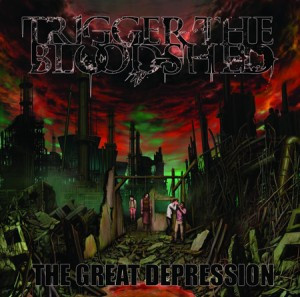 With The Great Depression, the band not only had to combat the prejudices of the metal world at large, along with the potentially deadly second-album syndrome, but also had to suffer the indignity of replacing their vocalist – a make or break moment for many young bands.
With The Great Depression, the band not only had to combat the prejudices of the metal world at large, along with the potentially deadly second-album syndrome, but also had to suffer the indignity of replacing their vocalist – a make or break moment for many young bands.
Immediately noticeable is an absence of the artificiality of production which prejudiced many listeners against their first release. The drums are more carefully placed in the mix, far less triggered and far more natural in both sound and delivery. The vocals of new boy Jonny Burgan are not (yet) as overwhelmingly powerful, nor in truth as varied, as his predecessor, but his delivery fits slightly more naturally into the album as a whole. There’s also more emphasis on the nuances that make certain songs and certain sections more stand-out and generally more rewarding to listen to.
Title track “The Great Depression” gets the album off to a great start, some sinuous riffing demonstrating a greater grasp of compositional subtleties and carefully controlled technical ability. The guitar and drum work are both extreme yet restrained for the majority of the track’s lengths, displaying a greater sense of self-awareness than was perhaps found on their debut, although both are allowed to cut loose for a time during the bridge.
“Warbound” is perhaps a more overtly technically gifted number, atonal sequences of notes combined to disturbing effect, culminating in a monolithically heavy end set-piece that employs a Nile-esque juxtaposition of slow, doom-laden riffing with fast foot-work and an eerie tremolo-picked lead line. This is, however, the first track to display some of the limitations of Jonny Burgan’s vocal range, his higher register vocals coming across as somewhat strained and forced when compared to his more prominent mid- and low-register vocal work.
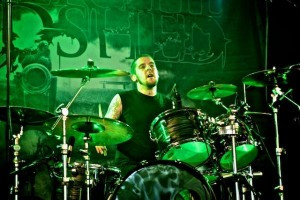 “Sanctuary Of The Wretched” and “Contemporary Perception Narcotics“ are amongst the best tracks on offer here, effortlessly displaying the sheer well of technical ability the band is able to plumb. The former is a scything piece of work which balances its million-notes-a-minute playing with some clever bass parts and some great non-traditional melodies, the riffs and structures strongly reminiscent of recent Decapitated. The latter demonstrates the band’s growing grasp of the important dynamics of extreme metal, shifting gears from fast, to faster, to fastest, before plummeting back down into slower, grimier speeds to allow the song time to breathe and decay naturally.
“Sanctuary Of The Wretched” and “Contemporary Perception Narcotics“ are amongst the best tracks on offer here, effortlessly displaying the sheer well of technical ability the band is able to plumb. The former is a scything piece of work which balances its million-notes-a-minute playing with some clever bass parts and some great non-traditional melodies, the riffs and structures strongly reminiscent of recent Decapitated. The latter demonstrates the band’s growing grasp of the important dynamics of extreme metal, shifting gears from fast, to faster, to fastest, before plummeting back down into slower, grimier speeds to allow the song time to breathe and decay naturally.
By and large, the band’s attempts to re-capture or expand upon the grandiose atmospherics occasionally suggested by their debut have been toned down on this album. Although moments of “Warbound”, “Sanctuary…” and “The Dead World” hint at deeper undercurrents of mood and emotion, the band is clearly more focused on creating a taut, technical form of socially conscious modern death metal.
However, in keeping with the band’s keener embracing of more “traditional” (and I use the word with trepidation) death metal values, there is increased emphasis on lead work on this album, which helps add flair and character to the song-writing and separates the songs as more distinct entities. The short solo on “Dessicate Earth” (whose mid-section is one of the album’s heaviest moments) paints with a distinctly different palette than the rest of the song, adding a welcome splash of colour, whilst the solo on “The Infliction Of Tophet” (a song with a subtly crushing, mid-paced main riff) mixes up off-putting dissonance with fluid runs and taut bends.
Overall, the second album is more consistent and more directed in style and delivery. The minor flaws it displays are mainly insignificant when placed next to the improvements in quality and ability displayed by the band. Though it lacks as many sheer stand-out tracks as their debut, each track itself now has stand-out elements that raise the average standard of their song-writing as a whole by comparison.
Recommended song – Sanctuary of the Wretched
Degenerate – 2010
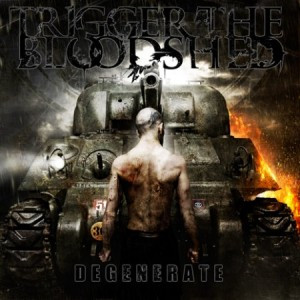 On their third album TTB struck gold in terms of achieving a balance between memorable song-writing and bone-crushing brutality, mixing the catchiness which periodically elevated their debut album to “One to Watch” status with the more organic song-writing and believable aggression from their second album. The addition of former Aborted (and current The Order Of Apollyon) drummer Dan Wilding on drums is also a boon for the band, his performance bringing more confidence and flair due to his greater experience. Vocalist Jonny Burgan has expanded his range and sharpened up his delivery further, achieving harsher highs and more rumbling lows and really pushing his performance.
On their third album TTB struck gold in terms of achieving a balance between memorable song-writing and bone-crushing brutality, mixing the catchiness which periodically elevated their debut album to “One to Watch” status with the more organic song-writing and believable aggression from their second album. The addition of former Aborted (and current The Order Of Apollyon) drummer Dan Wilding on drums is also a boon for the band, his performance bringing more confidence and flair due to his greater experience. Vocalist Jonny Burgan has expanded his range and sharpened up his delivery further, achieving harsher highs and more rumbling lows and really pushing his performance.
Immediately, “A Vision Showing Nothing” demonstrates the vast jump in quality the band have made. The vocals demonstrate their greater range and seem (if possible) more believably hate-filled than before. The drum sound is sharp and punishing but not overly produced or processed, and the performance itself is captivating and impressive without being overly-flashy or detracting from the song. The guitar work has taken a noticeable step-up in technical proficiency, without falling into the trap of employing needless technicality to cover-up deficiencies in the song-writing, the fleet-fingered playing now employed in the composition of a stream of shredding, grinding, rolling death metal riffs that stick in the mind like a virus. Follow-up “De-Breed” is, if anything, even more aggressive than the opener, employing the sheer power of SLOW in a manner that speaks volumes of the band’s appreciation for classic death metal song-writing.
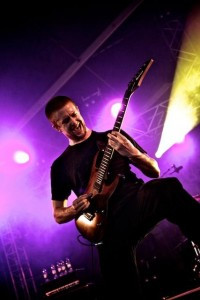 “Hollow Prophecy” features some hypnotic, Morbid Angel-esque riffage which breaks up (and breaks down) the relentlessly blasting nature of the song. It also features some of the most guttural growls on the entire album, a new depth of vocalist Jonny Burgan’s range having been discovered. The solo in the mid-section, whilst short, also serves to drive home the Morbid Angel influence on this track. By contrast “The Soulful Dead” is the song most likely to be identified as having residual “deathcore” elements, mainly due to the rhythmic change at the 2:30 mark. However such a tightly written part is as much Decapitated as it is Whitechapel, and so drawing the distinction between the “right” and “wrong” uses of such elements seems a largely arbitrary decision in light of the high quality material on offer.
“Hollow Prophecy” features some hypnotic, Morbid Angel-esque riffage which breaks up (and breaks down) the relentlessly blasting nature of the song. It also features some of the most guttural growls on the entire album, a new depth of vocalist Jonny Burgan’s range having been discovered. The solo in the mid-section, whilst short, also serves to drive home the Morbid Angel influence on this track. By contrast “The Soulful Dead” is the song most likely to be identified as having residual “deathcore” elements, mainly due to the rhythmic change at the 2:30 mark. However such a tightly written part is as much Decapitated as it is Whitechapel, and so drawing the distinction between the “right” and “wrong” uses of such elements seems a largely arbitrary decision in light of the high quality material on offer.
While a song like “Dead Vein” spoons a greater heap of melody into the stew, particularly with its infectious intro/refrain riff and tremolo-led mid-section (also incorporating a short, wah-inflected solo which is a welcome change of pace), other numbers such as follow-up “Dethrone” feature a more atonal sense of anti-melody; the songs have hooks and remain memorable by virtue of their tight structuring and the quality of their riffs balanced out with a keen sense of melodic nuance that is rarely overtly displayed.
The re-recording of “Whited Sepulcher” is a welcome surprise, the massive production values immediately elevating it over its predecessor. The more natural drum-work of Dan Wilding is a real boon, making the song sound far more believable in its intentions and delivery. I always felt the song promised far more than was originally delivered and it is a pleasure to see the band revisit it with the benefit of added maturity.
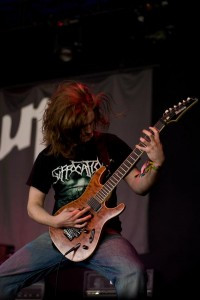 The increased technicality on display reflects a band maturing in both their abilities and the scope of their song-writing; never pushing into unnecessary “tech” realms, the riffing and structures balance fleet-fingered finger work with carefully constructed refrains which, rather than being excessively predictable, add some welcome and massive hooks to a primarily non-melodic style of music.
The increased technicality on display reflects a band maturing in both their abilities and the scope of their song-writing; never pushing into unnecessary “tech” realms, the riffing and structures balance fleet-fingered finger work with carefully constructed refrains which, rather than being excessively predictable, add some welcome and massive hooks to a primarily non-melodic style of music.
Another step forward for the album is the greater emphasis on the crafting of intelligently written lead parts that, rather than simply being an attempt to pander towards a more traditional style of death metal, actually organically add to each song’s overall style and mood. “De-Breed” and “Dethrone” are perfect examples of this, their solo spots having multiple parts and movements, progressing naturally from start to finish. These prominent solos spots serve to recapture some of the promised majesty from their debut record, raising each song above a simple collection of brutal riffs and adding a sense of dark grandeur to the proceedings. Even some of the less prominent solo spots add welcome flavour, particularly where the band employs judicious use of the wah-pedal to add a different character (see the first mini-solo of “A Sterile Existence” for another example of this).
Clearly the band have taken their time to develop their sound, learning from the mistakes and correcting the weaknesses of their first two records. As tight a killing machine as any I could mention at the moment, I foresee greater things ahead for this band if they can build upon the unparalleled success of “Degenerate” and really manage to carve out their own specific niche in the death metal world.
Recommended Song – A Sterile Existence
Recommended For Fans Of: Misery Index, Job For A Cowboy, Decapitated
********
EDITOR’S NOTE: Andy made this point in his discussion of TTB’s first album, Purgation: “I’d also question the decision to break up certain tracks in the manner that has been done; for example the punishing “Rebirth”, replete with massive central breakdown, flows in and out of a massive groove before leading into the Nile-esque majestic riffs and keys of “The Defiled” – these tracks work so well together I don’t fully understand why they aren’t simply considered as one song.”
To prove his point, Andy used audio editing software to turn “Rebirth” and “Defiled” into a single song and sent me the file to check out — and it’s just too damned cool not to share. So check it out here:

Degenerate was one of my favorite Tech Death albums of last year, an almost complete 360 from their past sound
oh and the record was very HEAVY
Agree — and I was surprised it didn’t get more attention, especially in year-end lists. The remnants of that “core” label may have prejudiced them in the eyes of snootier critics.
I don’t know, it still sounds kind of ‘core to me. It souned like something I would want to listen to, but I wasn’t really diggin it. The Defiled sounded like a cross between tech and core and I liked it a little better. At least there weren’t any ‘pig sqeals’. [shudders]
I agree that the first album was slightly “core” (although I still think it’s worth suggesting that this is a coincidence, rather than by design?) but think they exorcised that quite quickly.
One of the problems with distinguishing “core” from “tr00” death metal (god, that even hurt to type, my fingers are bleeding) is that, apart from the two genres being a hell of a lot closer than anyone wants to admit – often it’s simply a matter of age and approach to the music, rather than the music itself – is as follows (warning: opinion approaching)…
A lot of new, young, “tr00” death metal bands follow quite closely the template lain down by one (or at most two) of their progenitors. Stylistically this makes it easy to distinguish them as such (not that I’m saying they’re derivative) as their roots are easy to trace.
However a lot of bands considered “core” (and I am referring to bands without the image, outlook and over-reliance on generic, faux-tough guy beatdowns) these days are considered so because they pull from multiple sources of death metal. The mixing of influences from several different strains of “original death metal” muddies the waters somewhat, making it harder to trace their roots and “prove” their mettle/metal that way.
Does that make sense?
Also – pig squeals have no value.
I disagree strongly. Saying that pig squeals have no value is just rank discrimination against pigs everywhere.